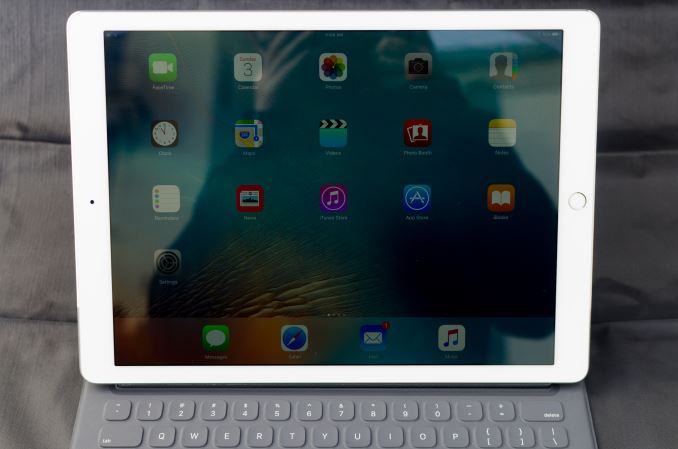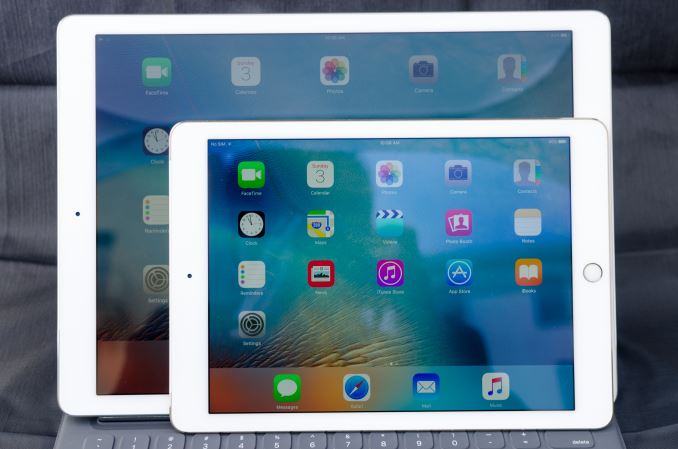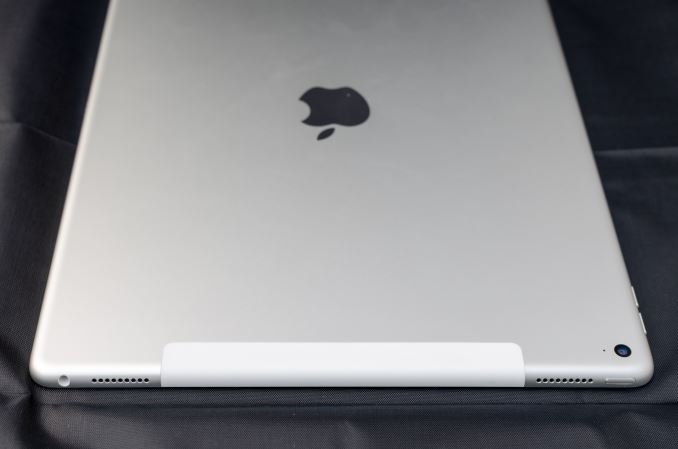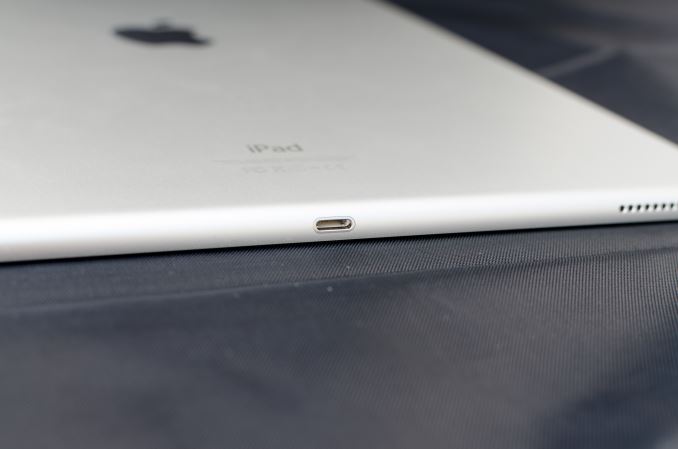The Apple iPad Pro Review
by Ryan Smith, Joshua Ho & Brandon Chester on January 22, 2016 8:10 AM EST
At this point it probably isn’t a secret that tablet sales have leveled off, and in some cases they have declined. Pretty much anywhere you care to look you’ll see evidence that the tablet market just isn’t as strong as it once was. It’s undeniable that touch-only tablets have utility, but it seems that the broader market has been rather lukewarm about tablets. I suspect at least part of the problem here is that the rise of the phablet has supplanted small tablets. Large tablets are nice to have, but almost feel like a luxury good when they’re about as portable as an ultrabook. While a compact laptop can’t easily be used while standing, or any number of other situations where a tablet is going to be better, a compact laptop can do pretty much anything a touch-only tablet can. A laptop is also going to be clearly superior for a significant number of cases, such as typing or precise pointing.
As a result, large touch-only tablets feel like they’ve been limited to home use as a computer away from the computer. Tablets are great when you’re on the couch or in bed, but once you get to this point there are some obvious questions as to whether it makes sense to drop $500+ USD on a tablet that seems to have relatively limited utility. The Surface lineup has been showing signs of growth, but in general the Surface is more of a mix between laptop and tablet rather than a tablet. I would argue that given the OS and overall design that the Surface and Surface Pro are really more laptop than tablet, even if at the hardware level the Surface Pro 4 and Surface 3 are basically tablets with kickstands and keyboard covers.
If you’re guessing that this means Apple has had some issues with growing sales of their iPad lineup, you’d be right. From my first experiences with the iPad 3, I was impressed with the improved user experience for things like web browsing and other smartphone tasks, but I never really felt like it made enough sense to get one for myself. The iPad Air 2 was once again impressive and I felt like I could recommend it to other people that wanted a tablet, but I personally struggled to come up with a reason why I would buy it.
This brings us to the iPad Pro. This is probably the first time Apple has seriously deviated from traditional iPad launches, putting together a tablet built for (limited) productivity and content creation rather than just simple content consumption, creating what's arguably the iPad answer to the Surface Pro. To accomplish this, Apple has increased the display size to something closer to that of a laptop, and we see the addition of a stylus and a keyboard cover for additional precision inputs. Of course, under the hood there have been a lot of changes as well, so the usual spec sheet can be found below to summarize those changes.
| Apple iPad Air 2 | Apple iPad Pro | |
| SoC | Apple A8X 3 x Apple Typhoon @ 1.5GHz |
Apple A9X 2 x Apple Twister @ 2.2GHz |
| GPU | PowerVR 8 Cluster Series6XT (Apple GXA6850) |
PowerVR 12 Cluster Series7XT |
| RAM | 2GB LPDDR3 | 4GB LPDDR4 |
| NAND | 16/64/128GB | 32/128GB |
| Display | 9.7" 2048x1536 IPS LCD | 12.9" 2732x2048 IPS LCD |
| Size and Mass | 240 x 169.5 x 6.1mm 437g WiFi, 444g LTE |
305.7 x 220.6 x 6.9 mm 713g WiFi, 723g LTE |
| Camera | 8MP Rear-Facing, f/2.4, 1.1 micron, 1.2MP Front-Facing, f/2.2 | |
| Battery | 27.3Wh | 38.5Wh |
| Launch OS | iOS 8 | iOS 9 |
| Cellular Connectivity | MDM9x25 Category 4 LTE + GPS/GNSS in Cellular SKU | |
| Other Connectivity | 2x2 802.11a/b/g/n/ac + BT 4.2, Apple Lightning | |
| SIM | Optional NanoSIM | |
| Price | $499/599/699 16/64/128GB | $799/949/1079 32/128GB/128GB LTE |
At a high level, the iPad Pro gains a larger display with a higher resolution, more memory, a new SoC, and a larger battery to compensate for the change in display size. In addition to these changes, the iPad Pro also brings noticeable changes to the speakers, with an increase to four speakers which allow the iPad Pro to compensate for device orientation when projecting stereo audio.
Design
The most immediate change that you can see in the iPad Pro is the sheer size. The 12.9” display of the iPad Pro basically makes it feel like you’re carrying a laptop around. I would argue that this doesn’t actually affect the portability of the iPad Pro, but this is mostly because the iPad Air 2 was something that I only carried in a backpack to begin with. People carrying their tablets in a small bag, purse, or even just in their hands will notice the difference, so the change in size might be more or less noticeable depending upon how you carry things around.
The increase in size does affect weight. After significant use, I honestly don’t think the mass is a significant issue. It does feel heavier than the iPad Air 2, but the mass distribution is such that there isn’t a ton of battery hanging out at the edges of the device where it’ll affect the moment of inertia. This does raise the question of whether Apple included enough battery for sufficient battery life, but that’s a question best left for the rest of the review.
In terms of design, the iPad Pro is rather unremarkable if you’ve ever seen an iPad Air before; it is for all intents and purposes a bigger iPad Air. On the front, the display dominates, with some bezels on the sides and top. The top has the front-facing camera, and the bottom has the home button with TouchID.
Looking at the sides of the tablet, the top edge has the power button and 3.5mm port, along with two of the four speakers. The right edge has the volume buttons, and the bottom edge has the Lightning port and the other two speakers. The left edge is mostly empty, but contains the Smart Connector for the Smart Keyboard and similar accessories.
The back of the tablet is mostly unremarkable as well. For the LTE model, an RF window is visible on the top of the device to allow LTE and other connectivity to function. For the WiFi variants, it looks like the bottom display bezel and the bottom two speakers are the RF windows, so there aren’t any visible areas that indicate where the WiFi antennas are.
Overall, the iPad Pro feels like an iPad, with nothing all that remarkable beyond its size which is carried well. I never really noticed the mass or size of the iPad Pro even if it is clearly larger and heavier than the iPad Air 2. I also didn’t notice any issues with the back cover flexing, but given enough pressure on the back cover pretty much any device this large will see some screen distortion or bending. The iPad Pro does technically regress in thickness compared to the iPad Air 2, but I never noticed the difference in practice, especially when the larger display is really what matters more.
















408 Comments
View All Comments
zodiacfml - Saturday, January 23, 2016 - link
Anandtech needs more people. Where is that video which records the latency of the Apple pencil or SP4? Aren't musicians and sound engineers be interested in the tablet for simple creation of music which I meant, audio should be tested? If testing methodology of Wi-Fi has problems, wouldn't it be nice to test if one could play or edit a high bit rate video saved from a high performance NAS? The device is a small niche but Anandtech could put some more analysis just for the entertainment/education value of it.JoshHo - Saturday, January 23, 2016 - link
Regarding stylus latency, the videos would be quite boring as it's nothing more than a straight line with the stylus. I've simply taken those videos and done multiple trials and averaged times to determine the approximate latency of the stylus system.We would like to properly test speaker and 3.5mm output. We're working on these things but it looks like 3.5mm output testing is quite difficult.
We are also working on WiFi testing. This one will prove to be quite interesting as well.
zodiacfml - Saturday, January 23, 2016 - link
Thanks. I just thought the device deserves more analysis and work based on the amount of interest and comments here. I have one more critique on camera testing. Why is it not possible to have a static object or studio for camera testing since Anandtech constantly review mobile devices which will make the tests faster to produce and output to be easily comparable between devices?name99 - Sunday, January 24, 2016 - link
One more issue. When you test storage throughput, do you use traditional file IO or memory mapped files? Apple has ALREADY indicated a strong preference that developers use memory mapped files, and as we move to a world on NVM living more or less directly on the memory bus, memory mapped IO will become SUBSTANTIALLY more performant than traditional file IO.It seems to me incumbent that your testing become prepared for this new world today (maybe by running tests both ways and reporting both speeds, or the higher speed); otherwise at some point soon (and it may be as soon as two or three years) Apple or Samsung or MS are going to ship the first consumer device using NVM, and your storage performance tests are just going to look dumb because you're not simply not accessing the storage properly.
dontlistentome - Saturday, January 23, 2016 - link
5 hours to charge? If you started a working day on this with a flat battery and worked on it for 8 hours, would the battery even have charged by the end of the day?digiguy - Saturday, January 23, 2016 - link
As an ipad pro owner (128GB wifi), I'll give my opinion after owning it for around 2 months and reading this review (plus many others before this one, none as detailed, the best so far had been that of notebookcheck) and 166 comments. I also own a Surface pro 3, a Surface 2, a galaxy note 8, an ipad air and ipad mini 2, plus a few convertibles and a few laptops (no Macs however, Windows only). As expected, in the comments there was the traditional battle full OS vs mobile OS. Microsoft has proven how hard is to make a full OS easy to use on a tablet (some people here don't seem to understand what a titanic effort would be making OSX and its app good for tablets). Of course MS itself cannot control most apps and impose a touch friendly version. They tried the route of a mobile OS with RT but unfortunately it failed. It has to be said that Metro itself had some serious shortcomings, like the lack of a decent touch optimized file manager, onscreen keyboard issues etc. It's not easy to transform a desktop OS into a touch optimized OS and I understand why Apple has not and certainly will never try to make OSX for tablets. Same for Google, they tried to make chrome for touch with pixel c, but gave up and used android. Having said that, let's come to why I bought the ipad pro (especially while owning an SP3). First of all, screen size, I wanted something bigger to display documents in true A4 size, and the additional inch plus the better 4:3 ratio achieve that. The alternative would have been the surface book, but it's too expensive for just this (and has too compromises to replace my asus ultrabook, let alone my desktop replacement). Second reason was IOS music apps. IOS is the only mobile platform that can be used to a decent extent professionally by musicians. And this is great for sound libraries that can be used for example directly on the music rest of a piano/keyboard while connected to it via midi. Or to replace a mixer etc, where touch is essential. You can do this on Windows tablets, but software is not well optimized for touch and you often need anti-piracy dongles etc. so that a single USB port is not enough. None of that is necessary on IOS. Ipad pro sound, the best for any tablet, makes it useful without having to plug an external speaker in some circumstances (ex hotel room for working on music creation). Also an Ipad pro can act as a secondary monitor with duet display. And at it's size it can become useful, contrary to other ipads. So to sum up, screen size (and quality), high quality touch apps (for use cases in which touch is very important) without need for antipiracy dongles (widespread for music software) and sound. And this without mentioning the pencil (I am not an artist and only need to annotate PDFs, and for that I use my SP3, so haven't bought the pencil yet or the keyboard for that matter). Now, the shotcomings of ipad pro: Lack of a kickstand (with variable angles), lack of a pencil holder. Both can be solved by spending another 80$ for a urban armor gear case, with which the ipad pro is still lighter than SP3 with type cover. Lack of a file manager. This can be solved (to a decent extend) by buying a software called imazing. That's another 40$ but gives you a proper file manager and the possibility to copy file and folders from a pc to ipad. Other than that, some apps allow to sync you dropbox folders to ipad. Lack of storage expansion. Again spend the money for the 128GB version. As for SP3, screen is reflective, but, as for SP3, a matt screen protector works great and make the screen even more beautiful (no fingerprints, colors look even better without reflections). IOS not optimized enough for 12.9 inches, yet. No solution yet, we can only wait for IOS 10. So, with money you can fix many of the shortcomings, but is the over 1000$ necessary for that, justified? I would say probably not yet. But by buying the ipad pro I made a sort of bet on Apple to optimize IOS for better multitasking etc. and on IOS developers to continue making pro apps (especially for music, in my case), while already taking advantage of what it already offers. And the sheer power of this machine, so far not completely used, should make it a future-proof device, much more than other ipads (ready for IOS 10, 11, etc and for new powerful apps). What about Surface pro 3? Well to be honest, other than for annotating, I use it mainly as a very portable laptop on the go (only bring the 14 inches ultrabook when out for several days) with a nice, but not absolutely necessary, touch screen and nice pen input for taking handwritten notes. So mainly as a very convenient laptop rather than a tablet (as probably most Surface pro owners do too). As a tablet for the bed or for checking emails etc. on the go, my android phone or one of my 8 inch tablets are the most convenient devices....Klug4Pres - Saturday, January 23, 2016 - link
One of the better walls of text I have read, thank you.digiguy - Saturday, January 23, 2016 - link
thanks! well, I myself was impressed by how long it was... I only realized after I posted it.... ;-)id4andrei - Saturday, January 23, 2016 - link
Damn man, insert some spaces between ideas. Segmentation.digiguy - Saturday, January 23, 2016 - link
Yeah, right, sorry, the writing box is so small that I didn't think about layout. Next time I'll write in Word first and then copy...